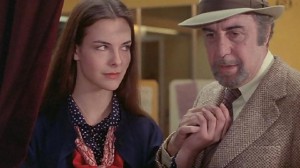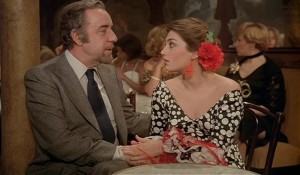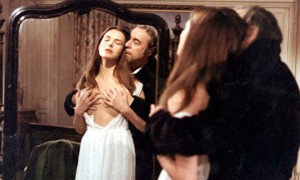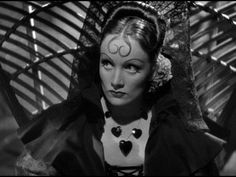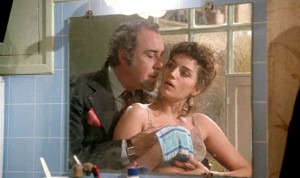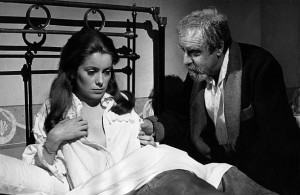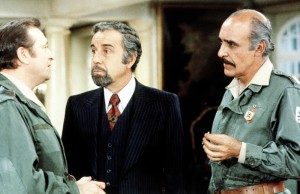I’ve been revisiting a good many of Buñuel’s films lately, and a couple of traits of his work as a whole that I haven’t been sufficiently aware of in the past have been the centrality of class issues and his uncanny ability to predict or anticipate the future — not only the rise of terrorism but an escalation in income inequality and even, to my surprise, some of the lessons of feminism. These are traits that come together most tellingly and provocatively in his final feature, That Obscure Object of Desire (1977).
I’ve previously regarded this film as a bit of a letdown after the formal radicalism and thematic freedom of its immediate predecessors, The Discreet Charm of the Bourgeoisie (1972) and The Phantom of Liberty (1974). But it’s now more apparent to me that the play with multiple narratives really starts with The Milky Way in 1969 (or, much earlier, with Un chien andalou and L’age d’or), that the inability to complete a sex act in That Obscure Object complements and rhymes with the inability to finish a meal in The Discreet Charm, that the economic and sexual exploitation of That Obscure Object is already present in Tristana (1970), and that despite Buñuel’s reputation for kinkiness and cruelty, sadomasochism has never been his particular forte. So unlike Josef von Sternberg’s 1935 The Devil is a Woman, based on the same novel (Pierre Louÿs’ 1898 La femme et le pantin), That Obscure Object of Desire isn’t the film of a masochist — nor is it really the film of a sadist, either.
In a highly informative interview included on the Studiocanal Blu-Ray, Jean-Claude Carrière points out that when he and Buñuel collaborated on their half-dozen scripts, he typically spoke for the male characters and the supposedly macho Buñuel spoke for the female characters — including the chambermaid in Diary of a Chambermaid, the title heroine of Belle de jour, and Conchita in That Obscure Object of Desire. Consequently, insofar as That Obscure Object needs to be seen beyond the complacencies of male privilege and class entitlements, it actually anticipates the recent “Me too” movement. Above all, it recognizes that male sexual entitlements and class entitlements usually turn out to be densely interwoven.
Simply identifying with the sexual frustrations of Don Mateo, the narrator-hero played by Fernando Rey, as I did back in 1977, typically means dismissing or at least minimizing the economic frustrations and resentments of Conchita (played alternately by Carole Bouquet and Angela Molina). And as Raymond Durgnat once pointed out, the two Conchitas/ actresses “[aren’t] just two facets of one woman. They’re different women. Differences of physique become differences of style, differences of style becomes class differences. The brunette is classically proletarian, the blonde is characteristically petit bourgeois.” Even so, neither of these Conchitas is anywhere close to being an economic match for Don Mateo, whose glibly unexamined entitlements are quite similar to those of Don Lope (Fernando Rey again) in Tristana.
The first two films of Buñuel are those of a spoiled rich kid, cosigned by his partner in entitlements Salvador Dali. Las hurdes changed that profile, and the twenty or so Mexican films that followed confirmed his proletarian humanism, with only The Exterminating Angel anticipating most of the late French films in returning to Buñuel’s own class. I’ve often pondered the reasons why Raúl Ruiz always preferred the Mexican Buñuel to the French Buñuel, and I’m now inclined to think that class had a lot to do with it. (Even if Buñuel spoke for Conchita at the scripting stage, Carrière notes that he had two on-screen surrogates that represent his two male class positions, Francisco Rabal and Fernando Rey.)
To cite only one example of That Obscure Object’s uncanny relevance to the present, consider the very last glimpse that we have of Don Mateo and Conchita as a couple, just before the latest terrorist bomb explodes — a nearly exact replica of the gesture caught of Melania rejecting Donald’s hand when they were traveling abroad. [1/4/2018]

